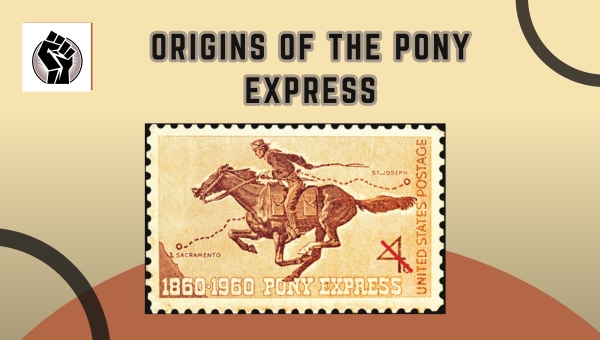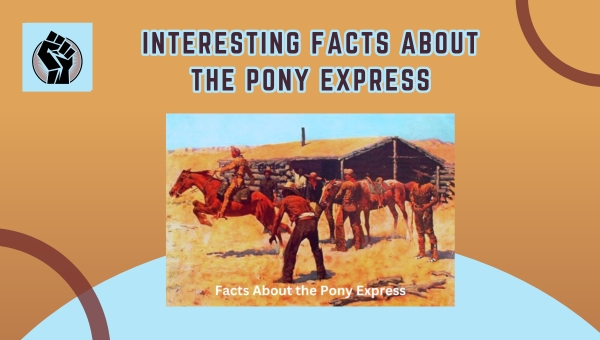Imagine a time when the fastest way to send a message across the vast American landscape was on horseback. This was the reality of the 1860s when the Pony Express blazed a trail through history. Riders, undeterred by treacherous terrain and harsh weather, embarked on a mission to connect the East and West. This service was a beacon of hope and progress in a divided nation.
The Pony Express history is a testament to innovation and determination, capturing the essence of an era eager for connection. As we delve into its storied past, we uncover the challenges, triumphs, and legacy of this legendary enterprise.
Origins Of The Pony Express
The Pony Express was a pioneering venture that sought to revolutionize mail delivery across the vast American landscape during the 1860s. Its inception was driven by the urgent need to connect the East and West coasts more swiftly than ever before. To understand its beginnings, it’s essential to delve into the challenges faced and the visionaries who brought this remarkable service to life.

Early Mail Delivery Challenges
Delivering mail across the expansive terrain of the United States in the mid-19th century posed significant hurdles. Traditional methods, such as stagecoaches and ships, often meant long delays, with messages taking weeks to reach their destinations.
The journey was fraught with obstacles including rugged landscapes, unpredictable weather, and the risk of confrontations with hostile entities. These factors underscored the dire need for a more streamlined and reliable mail delivery system, especially as communities expanded westward.
Founding Companies
The establishment of the Pony Express was spearheaded by three ambitious entrepreneurs: William Russell, Alexander Majors, and William Waddell. Together, they formed the Central Overland California & Pike’s Peak Express Company in 1860.
Their collective expertise in freight and transportation was crucial in launching this bold venture. Despite initial skepticism from the public about its feasibility, their strategic planning and unwavering determination led to the creation of a service that would become legendary in American history.
Also Read: Walt Disney Company – Its Magical Journey
The Route And Operations
The Pony Express was renowned for its meticulously planned route, stretching nearly 2,000 miles from St. Joseph, Missouri, to Sacramento, California. This trail was more than just a path; it was a lifeline connecting the East and West.
The operations were a testament to the daring and determination of riders who braved diverse landscapes to deliver mail swiftly. Let’s explore the geographical path they took and the crucial waypoints where these exchanges took place.
Geographic Path
The geographical path of the Pony Express was a marvel of organization and planning. Riders embarked on a journey that took them across vast plains, over rugged mountains, and through arid deserts.
The route was carefully chosen to ensure the fastest possible delivery times, navigating through some of America’s most challenging terrains. This path was not just significant for its physical challenges but also for its role in establishing a reliable overland communication link during a crucial period of expansion.
Key Waypoints
Key waypoints along the Pony Express route were vital for the operation’s success, serving as exchange points for riders and horses.
Here’s a list of significant stations that played a crucial role in its operations:
- St. Joseph, Missouri: The starting point of the Pony Express, initiating the long journey westward.
- Fort Kearny: A critical stop for rest and horse changes, ensuring the continuation of the journey.
- Fort Laramie: An important military outpost providing support and security for riders.
- Salt Lake City: A significant urban center along the route, offering logistical support.
- Sacramento, California: The final destination for westbound deliveries, marking the end of the trail.
These waypoints were more than just stops; they were the backbone of the entire Pony Express operation, ensuring that the mail reached its destination efficiently.
Riders And Horses
The success of the Pony Express heavily relied on its riders and horses, who were integral to its operation. These individuals and animals faced numerous challenges as they traversed vast distances to deliver mail.
Understanding how riders were selected and the breeds of horses used is key to appreciating the efficiency and dedication behind this historical service.
Rider Selection And Roles
Choosing the right riders was crucial for the Pony Express. Here’s how they were selected and what their roles entailed:
- Physical Fitness: Riders needed to be in excellent physical condition to withstand long rides.
- Age Requirement: Most riders were young men, typically between ages 18 and 25, to ensure agility and endurance.
- Weight Limit: Riders were often lightweight, around 120 pounds, to ease the burden on horses.
- Responsibilities: They were tasked with not only delivering mail swiftly but also safeguarding it from threats.
- Commitment: Riders committed to riding through harsh weather and rough terrains, showcasing bravery and dedication.
Horse Breeds And Handling
The horses used were just as vital as the riders. Here’s a look at the breeds and their care:
- Mustangs: Known for their agility and stamina, these horses were often chosen for their ability to handle tough terrains.
- Thoroughbreds and Morgans: Occasionally used for their speed and endurance, enhancing delivery efficiency.
- Regular Care: Horses were fed and rested frequently at relay stations to maintain their health and performance.
- Horse Exchanges: Riders changed horses every 10 to 15 miles to ensure that each horse was fresh and could maintain high speeds.
The meticulous selection of riders and the strategic care of horses were fundamental to the Pony Express’s operation, enabling it to set a new standard for swift communication across the vast American landscape.
Communication Impact
The Pony Express revolutionized communication in America during its brief existence. This service dramatically reduced the time it took for messages to travel between the East and West, offering a new level of speed and efficiency.
Moreover, it played a crucial role in transforming how news and information were shared, influencing the media landscape of its time.
Speed And Efficiency
The Pony Express was a game-changer for communication speed in the mid-19th century. Before its inception, sending a letter from Missouri to California could take weeks. The Pony Express cut this time down to just ten days.
This was achieved by setting up a relay system with riders and horses, each covering a portion of the nearly 2,000-mile route. This efficient system ensured that mail was constantly moving, day and night, regardless of weather conditions.
As a result, the service provided a reliable and quick way to communicate across vast distances, which was vital for both personal and business correspondence.
Influence On Media And News
During its operation, the Pony Express had a significant impact on media and news dissemination. Newspapers relied heavily on its fast delivery to get timely updates and reports. This was especially important during events that needed rapid communication, such as political elections or developments related to the expansion of the American frontier.
The ability to quickly share news helped shape public opinion and kept citizens informed about national and local happenings. Through its contribution to the swift movement of information, the Pony Express played a pivotal role in the media landscape of its era, setting a foundation for faster communication methods that followed.
Also Read: Walmart History: A Journey to Retail Dominance
Decline And Legacy
The Pony Express, though short-lived, left an indelible mark on American history. Its decline was swift, driven by advancements in technology that rendered its services obsolete. Yet, its legacy persists, highlighting a significant chapter in the evolution of communication.

Let’s delve into the factors that led to its downfall and explore its lasting influence on communication history.
The Role Of Technology Advancements
Technological progress played a pivotal role in the decline of the Pony Express. As new innovations emerged, the need for its services diminished.
Here are some key advancements that contributed to its downfall:
- Telegraph Expansion: The rapid spread of telegraph lines offered instant communication, far surpassing the speed of horseback messengers.
- Railroad Growth: The expansion of railroads provided a more efficient and reliable means of transporting both people and mail across long distances.
- Cost Efficiency: Telegraphs and railroads proved more cost-effective than maintaining a network of riders and horses over vast terrains.
These advancements collectively marked a new era, signaling the end of the Pony Express.
Historical Significance
Despite its brief operation, the Pony Express holds a significant place in communication history. It represented a remarkable effort to connect distant regions swiftly, setting a precedent for future innovations.
The legacy of the Pony Express is reflected in several ways:
- It demonstrated the importance of reliable communication during a period of rapid national growth.
- The service became a symbol of the adventurous spirit and determination that characterized the American frontier.
- Its story continues to captivate and inspire, serving as a testament to human ingenuity and perseverance.
The Pony Express remains a celebrated chapter in the narrative of American progress, illustrating the transformative power of innovation in bridging great distances.
Interesting Facts About The Pony Express
The Pony Express stands as a remarkable chapter in American history, capturing the imagination of many with its daring and determination.

Here, we delve into some fascinating and detailed aspects of this legendary mail service:
- Duration of Operation: The Pony Express was a short-lived yet iconic service, operating from April 1860 to October 1861. Despite its brief existence, it left a lasting impact on the communication landscape.
- Distance Covered: Riders journeyed across approximately 1,966 miles in just ten days. This impressive feat was accomplished by a network of relay stations and dedicated riders who braved the elements to ensure timely delivery.
- Rider Demographics: Most riders were young men, typically between the ages of 18 and 25. These individuals were chosen for their stamina and agility, qualities essential for enduring the grueling rides.
- Cost of Service: Initially, the service charged a hefty $5 per half-ounce letter. This fee was quite substantial for the time, reflecting the urgency and novelty of the rapid mail delivery. Over time, prices were reduced, making it more accessible.
- Famous Riders: Among the riders were notable figures such as Buffalo Bill Cody and Pony Bob Haslam. Their exploits became legendary, contributing to the enduring mythos of the Pony Express.
- Remarkable Reliability: Incredibly, only one mailbag was reported lost throughout the entire operation. This statistic is a testament to the dedication and efficiency of the riders and support staff.
- Relay Stations: Approximately 184 relay stations were strategically placed along the route. These stations provided fresh horses and a place for riders to rest, ensuring the continuous and swift movement of mail across the country.
- Cultural Icon: The Pony Express quickly became a symbol of adventure and perseverance. Its story has been immortalized in folklore, representing the pioneering spirit of the American West.
These intriguing facts about the Pony Express reveal not only its operational prowess but also its cultural significance. Each element of this service—from its daring riders to its innovative logistics—contributed to its legendary status in American history.
FAQs
When was the Pony Express founded?
The Pony Express was established in April 1860. It was created to provide a faster mail delivery service between the eastern and western United States.
How long did the Pony Express last?
The Pony Express was operational for roughly 18 months. It ended in October 1861, when advancements like the telegraph rendered it obsolete.
How many Pony Express riders died?
During its short operation, it is believed that six riders lost their lives. The dangers they faced included harsh weather and difficult terrain.
Conclusion
The Pony Express history remains a testament to the determination and innovation of its time. Operating for a brief period, it bridged the communication gap between the East and West, demonstrating the need for rapid information exchange. While technological advancements eventually rendered it obsolete, its legacy endures, symbolizing adventure and resilience.
The Pony Express set the stage for future communication developments, marking a significant chapter in American history. If you enjoyed this journey into the past, explore more fascinating stories on our site. Discover insights that connect history to the present, enriching your understanding of our ever-evolving world.





